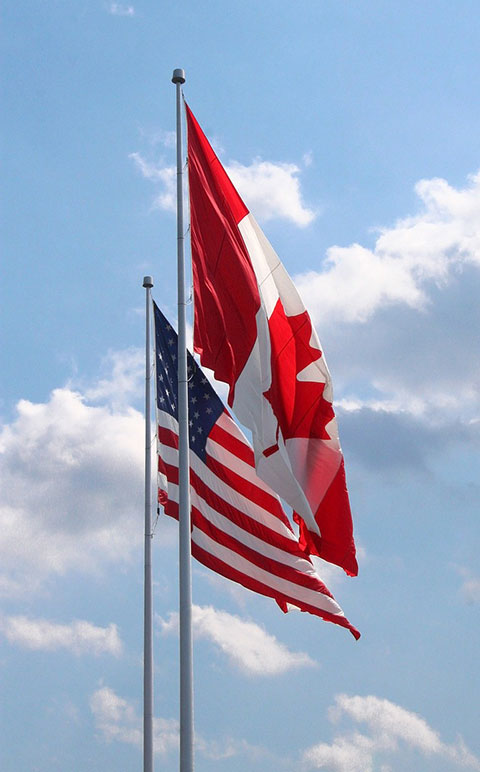Designing and exporting products to an international marketplace can be a challenging endeavor. What are the requirements? What documents are required? How do I register my business/brand?
The intent of this document is to answer those questions and aid the builder in better understanding the requirements of exporting recreational vessels/boats to Canada. The following is an overview of items required throughout the process. Individual steps may include hyperlinks to resources that will provide additional information on that requirement.
The requirements for exporting to Canada have been broken out into three categories.
- Construction requirements
- Documentation
- Additional documentation not related to Canadian Responsible Officer (CRO) responsibilities
 Construction Requirements:
Construction Requirements:
- Transport Canada has published a set of national Construction Standards for Small Vessels, referred to as TP1332. The current standards were issued in April of 2010. These standards are available at no charge and can be found here.
- As an alternative to TP 1332 Standards, Transport Canada issued the TIER I Policy, Acceptance of alternative construction requirements for small vessels (ABYC Standards). Details on this policy can be found here.
- The TIER I Policy used in combination with a Memorandum of Understanding (MOU) between Transport Canada and NMMA enables NMMA Certified boat and yacht manufacturers to ease the process of determining and declaring compliance with Canadian Regulations. More information on the MOU can be found here.
- When using the MOU, it is important to understand that some deviations between the applied ABYC standards and TP 1332 requirements exist. These deviations include:
- All Safety Notices prescribed by the Small Vessel Regulations and the alternative ABYC standards must be provided in English and French.
- All units marked on the vessels and accompanying documentation must use the International System of Units (SI). Additional use of pounds/inch units is permitted.
- Where applicable, a person weight of 75 kg (165 lbs.) must be used in all calculations and tests.
- Marine Spark-Ignition Engine, Vessel, and Off-Road Recreational Vehicle Emission Regulations: any person importing a prescribed class of engine, vessel or vehicle into Canada must submit a signed declaration to the Minister prior to importation.
- The U.S. EPA emission requirements are accepted as an equivalent to the Canadian Marine Spark-Ignition Engine, Vessel, and Off-Road Recreational Vehicle Emission Regulation.
Documentation:
- Manufacturers Identification Code (MIC): A MIC must be registered with Transport Canada to a Canadian resident representative (either an individual or a corporate entity) before products can be placed into the marketplace. Registering with Transport Canada can be completed through the link here. Using this same form, a Canadian-based manufacturer can apply to Transport Canada to obtain a MIC. This MIC is valid for use in both Canada and the U.S.
- The Canadian representative, referred to as the Canadian Responsible Officer (CRO) assumes responsibility for compliance of all vessels sold in Canada under the assigned MIC with Canadian construction requirements and the responsibility to provide the following documentation:
- Small Vessel Declaration of Conformity (DoC) or NMMA Addendum to DoC
- A DoC is required for every vessel sold in Canada that is power-driven or designed to be power-driven. For serially produced models, only one DoC is required to represent all the identical vessels built under that model name. For custom vessels, a DoC is required for each vessel.
- The completed original DoCs need to be signed by the CRO and submitted to Transport Canada for review. A copy of the DoC, as it was submitted to Transport Canada, must be included with the vessel at the time of initial sale.
- The GCKey (Government of Canada online application portal) can be used to generate a DoC and for completing the annual report. More information on this process can be found here.
- When submitting the DoC to Transport Canada the manufacturer shall also supply photographs, professional drawings or CAD documentation of the vessel in the following orientations:
- Top view
- Side view
- Stern view
- Compliance Notice: A compliance notice is the Capacity label (used on vessels <6m) and the Conformity label (used on vessels >6 m). The compliance notice shall be installed on every boat placed into the marketplace in Canada. Transport Canada does not provide compliance notices however their format is regulated. Information on how to correctly format a Canadian compliance notice can be found in Section 2 of TP1332 Construction Standards for Small Vessels.
- Annual Reports must be submitted by the CRO to Transport Canada each year by April 1. The GCKey (Government of Canada online application portal) can be used to generate the annual report. More information on this process can be found here.
Other Documentation (non-related to CRO responsibilities)
- Importation Declaration Form for Marine Spark-Ignition Engines, Vessels: Any person importing an engine, vessel or vehicle into Canada must submit, prior to importation, a declaration to the Minister, signed by that person or their duly authorized representative. This form can be found here.
- Commercially Hauled Watercraft Form (AIS): This form is required when sending shipments to Alberta and British Columbia. More information on this form can be found here.
- Province requirements may vary. Use the link here to contact local authorities for more information on the requirements of the shipments destination.
For more information on these requirements please contact Transport Canada’s Small Vessel Manufacturer and Importer Compliance Program (SVMICP) by email to: [email protected]
